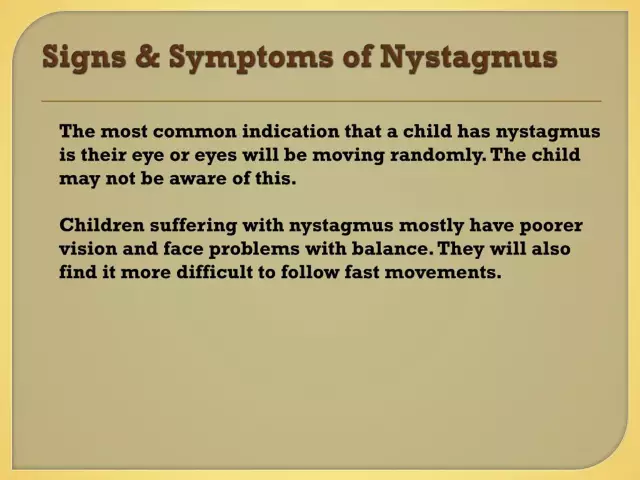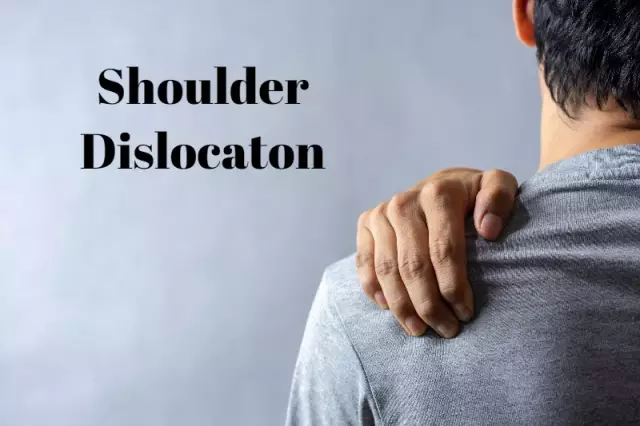- Author Rachel Wainwright [email protected].
- Public 2023-12-15 07:39.
- Last modified 2025-11-02 20:14.
Nystagmus

Sometimes it happens that, when talking with a person, you notice how his eyes are constantly moving. One gets the feeling that at least he is not interested in the topic of your conversation. But, unfortunately, a person can behave in a similar way due to the presence of such a disease as nystagmus, which in Greek means "drowsiness".
Eye nystagmus is a fairly frequent oscillatory movement of the eyes, in which a person cannot focus his gaze on one object. With this disease, as a consequence, a decrease in visual acuity is usually observed.
Causes of nystagmus
There are many reasons for the occurrence of this disease:
- Delayed fetal development during pregnancy;
- Consequences of birth trauma;
- Congenital or acquired visual impairment;
- Various eye diseases: myopia or farsightedness, strabismus, retinal dystrophy, astigmatism, optic nerve atrophy, opacity of optical media, etc.
In addition to all of the above, eye nystagmus can be caused by an infectious or traumatic lesion of the pons of the brain, cerebellum, pituitary gland, medulla oblongata, or labyrinth. Also, stroke and multiple sclerosis can lead to the development of nystagmus.
Abuse of various drugs or narcotic drugs can trigger the development of eye nystagmus. Frequent stressful conditions also contribute to the development of this disease.
Symptoms of nystagmus and its types
Nystagmus usually develops against a background of various problems associated with the visual system or neurological pathology. There are various classifications of nystagmus.
Depending on the oscillatory movements of the eyes, there are:
- Horizontal nystagmus. This is the most common type of pathology, when eye movement is directed to the right and left;
- Vertical nystagmus. The movements of the eyeballs are directed up and down;
- Diagonal nystagmus is diagnosed when eye movements are diagonal;
- Eye movements in a circle - rotational nystagmus.
The difference in the nature of the movements:
- Uniform rocking movements of the eyes from one side to the other - pendulum-shaped nystagmus;
- Slow movement of the eyeballs to the side with a quick return back - jerky nystagmus of the eyes;
- Mixed type.
Eye nystagmus happens:
- Congenital. In this case, jerky horizontal nystagmus is most often observed. Usually, the pathology manifests itself in the second - third month of a baby's life and, unfortunately, remains for life;
- Purchased. It is subdivided into installation, vestibular, and optokinetic.
Diagnostics

Involuntary eye movements allow the doctor to diagnose nystagmus almost immediately. But to identify its cause, it is necessary to conduct an in-depth medical examination of the patient.
When an ophthalmological examination is performed:
- Determination of visual acuity;
- Examination of the fundus and retina;
- Study of the functions of the oculomotor apparatus and the optic nerve.
After that, the patient is sent for a consultation with a neurologist and for electrophysiological studies:
- MRI;
- EEG;
- Echo-EG.
Nystagmus: treatment
The process of treating nystagmus is long and difficult. Therapeutic treatment, first of all, begins with the underlying disease that led to the development of this symptom. For example, correction of visual impairments is carried out: myopia, hyperopia, astigmatism, etc. This allows not only to reduce the manifestations of nystagmus, but also increases visual acuity. You can successfully use special computer programs: "Crosses", "Zebra" and "Spider".
In order for the tissues of the eyes and the retina to receive the nutrition they need, vitamins and vasodilators are used.
In rare cases, they resort to surgical treatment of nystagmus. During the operation, the surgeon tightens and strengthens the weakened muscles of the oculomotor apparatus, and vice versa, cuts, thereby weakening the stronger ones.
With congenital horizontal nystagmus, the child should be registered with a neurologist and ophthalmologist for up to 15 years. As already mentioned, it is impossible to completely cure congenital nystagmus of the eye. The main goal of therapy in this case is to prevent further progression of the disease and to maintain visual acuity.
YouTube video related to the article:
The information is generalized and provided for informational purposes only. At the first sign of illness, see your doctor. Self-medication is hazardous to health!






